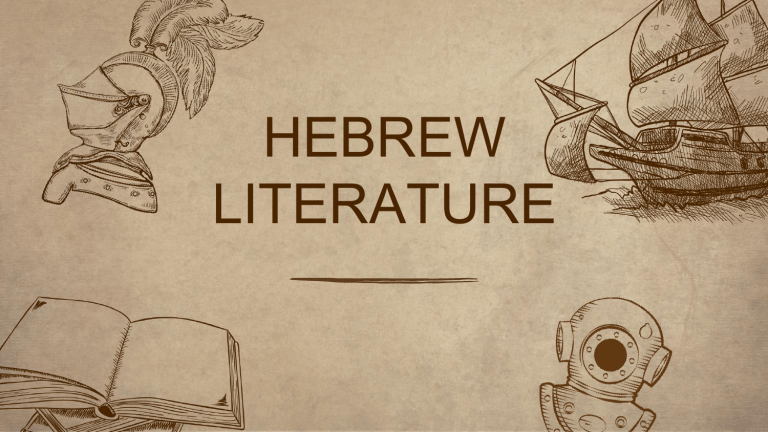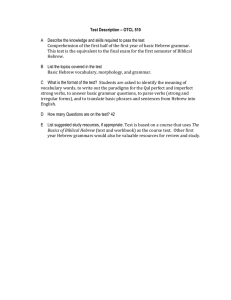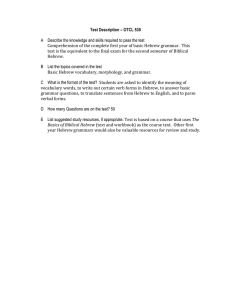
HEBREW LITERATURE OBJECTIVES: At the end of the discussion, students will be able to: • • • Identify the literary of Hebrews and it’s contribution. Describe the literary contribution of the Hebrews. Appreciate Hebrew Literature. ISRAEL FLAG • GEOGRAPHY Lies at the eastern end of the Mediterranean Sea. It is bordered by Egypt on west Syria, Jordan on the east, and Lebanon on the north. The Bible DC Museum 1,000 years Hebrew Bible • Hebrew Bible, also called Hebrew Scriptures, Old Testament, or Tanakh, collection of writings that was first compiled and preserved as the sacred books of the Jewish people. It also constitutes a large portion of the Christian Bible, known as the Old Testament. Except for a few passages in Aramaic, appearing mainly in the apocalyptic Book of Daniel, these scriptures were written originally in Hebrew during the period from 1200 to 100 BCE. The Hebrew Bible probably reached its current form about the 2nd century CE. From Hebrew Bible to Christian Bible: Jews, Christians and the Word of God • In his teaching, Jesus often quoted the Jewish Scriptures; after his death, his followers turned to them for clues to the meaning of his life and message. Biblical scholar Mark Hamilton discusses the history of these ancient texts and their significance for early Christians and their Jewish contemporaries. HEBREW LITERATURE Literature written by Jews in Hebrew and, by extension, certain theological and scholarly works translated from the Hebrew by Jewish scholars. Hebrew was the principal literary language of the Jews until the 19th century, when European languages came into use for works of modern Jewish scholarship and Yiddish became a vehicle of literary expression. Since the establishment of Hebrew as the official language of Israel in 1948, a large body of fiction and nonfiction has been written in the language • • 01 02 ETYMOLOGY WHO ARE THE HEBREWS? Hebrew comes from the Middle English word “EBREU“ Which come from the old French derived from the Latin word HEBRAEUS • • • Ancestors of Samaritan and Jews 03 WHAT COUNTRY DO THEY LIVE? • Descendants of the Hebrew Descendants of Biblical Patriarch • Ancient Middle East, 1400 BC they settle in Canaan( formerly known as Israel the country of the eastern coast Mediterranean sea that the territory of modern Israel Jordan Lebanon in Syria) Hebrew is a Member of the Canaanite group of Semitic languages (it was the language of the early Jews but from 586 BC it started to be replaced by Aramaic. 04 05 WHAT DID THEY EAT? WHAT DID THEIR BUILDING LOOK LIKE? • • • • Bread House made of sand dried mud • Meat bricks (for the wealthier people) • Fish • Wine Tent (poor or ordinary people) Jerusalem Temple or the Church of the Hebrew(the first temple was made by king Solomon and was covered by Gold) 06 WHAT DID THEY WEAR? • Fringes • Tekhelet ribbon • Tekhelet was translated in the King James Version KJV to mean blue, however, it means violet in Hebrew, not blue. HEBREW LITERATURE • It consists of ancient, medieval and modern writings in the Hebrew language. • It is one of the primary forms of Jewish Literature though there have been cases of literature written in Hebrew by non-jews. • It was produced in many different parts of the world throughout the medieval and modern eras. • Hebrew literature is largely Israeli literature. In 1966, Agnon won the Nobel Prize for Literature for novels and short stories that employ a unique blend of biblical, Talmudic and modern Hebrew, making him the first Hebrew writer to receive this award. ANCIENT HEBREW LITERATURE • Ancient Hebrew literature consists mainly of the Hebrew Bible (also known as the Old Testament ) • It forms the bedrock of much subsequent Hebrew literature as a source of authority, themes, and language. • Viewed in literary terms, the core of the Hebrew Bible is an epic saga that extends from the book of Genesis to the book of Kings and describes the formation of the Jewish people and their relation w.ith God. • This story is told through different kids of literary materials, mainly narrative, poetry, and law ANCIENT HEBREW LITERATURE • Literature in Hebrew begins with the Oral Literature of the Leshon Hakodesh or the "Holy Language". • The most important work of Ancient Hebrew is the Hebrew Bible named Tanakh. • Mishna - primary rabbinic codification of laws as derived from the torah. It was written in Mishnaic Hebrew. MEDIEVAL HEBREW LITERATURE • • During the medieval period, the majority of Jewish and Hebrew was composed in Islamic North Africa, Spain, Palestine, and Middle East. Many works of medieval philosophical literature such as Maimonides Guide to the Perplexed and the Kuzari, as well as many works of fiction, were written in Judeo-Arabic. • • • “Fox fables” is one work of fiction which was written in Hebrew by Berechiah haNakdan, a Jewish scholar who lived in 12th – 13th century France or England. Hebrew fables which resembles Aesop fables much medieval jewish poetry was written I Hebrew including the: Liturigical Piyyutim- in Palestine by Yose ben, Yose, Yanai, and Eleazae kalir. “The Siddur- written by Amram Gaon and Saadia Gaon. MODERN HEBREW LITERATURE • In addition to writing traditional rabbinic literature in Hebrew, MODERN Jews developed new forms of fiction, poetry, and essay writing which are called “Modern Hebrew Literature”. • Hebrew authors went a little further by exploring other genre. Although it is typical to see religious elements in Hebrew literature it is in modernity when other themes that add diversity to this branch are manifested. FOUNDATIONS OF HEBREW LITERATURE HEBREW BIBLE (Tanakh) • The Bible is the various collections of sacred scripture of the various branches of Judaism and Christianity. (jews have often been called the people of the book then the book is the Hebrew Bible which tells the history of the Hebrews and presents the basic laws and teachings of the jewish faith. TALMUD • A collection of numerous treatises which are chiefly dedicated to the laws and legends of the Jews. The Hebrew term Talmud means to study or learning commonly refers to a compilation of ancient teachings regarded as secret and normative by use from the time it was compiled. HEBREW BIBLE (TANAKH) CATEGORIES So jewish bible or tanakh is divided into three categories: • • • The Five Books of the Torah. which contains the law or teaching compromised origins of the Israelite nation. According to tradition they were writted by Moses. The Nevi’im (“prophets”) containing the historic account of Israel and Judah plus works of prophecy. The Ketuvim (“writings”) poetic and philosophical works such as the psalms and the book of job which contains a rich variety of general genres`or types of literature. SECTIONS • • • The Old Testament it is made with 39 books and classified in six groups history, poetic books, lyric poetry, drama, wisdom literature and tales. The New Testament is an account of the origin of the early development of Christianity. It is made of 4 biographies of Jesus which are the gospels, a church history, 21 apostles and unpocalypse. It has 27 books. The Apocrypha collection of 14 books it consist of 4 books of history 5 tales, 2 books of wisdom and 1 apostle, song and prayer.. CHARACTERISTICS OF HEBREW LITERATURE • • • • • There was no development of pictorial art on the other hand there was a important development of poetry and literature. Much of literature is related to religion The teachings and precepts that are compiled in the so-called sacred works. The first works are related to lived facts and personal experiences with God. The old testament has been translated into several languages. LITERARY GENRES POETRY PROPHETIC HISTORICAL Fictional stories, legends, myths and stories as well as biographical information about the messiah. Gender related to visions, oracles and announcements Most common genre LAW SAPIENTIAL Guide the Hebrews from the religious daily and moral Teachings and lessons 18th CENTURY “La- Yesharim Tehillah” - It is a allegorical drama 1st product of modern Hebrew Literature. It was written by Moses Hayyim Luzatto Moses Mendelsshon’s translation of the Hebrew Bible into German inspired interest in the Hebrew language that led to the founding of a quarterly review written in Hebrew. “Shire Tif’eret” and “Mosiade” - Poems made by Nephtali Hirz and Wessely. 19th CENTURY In the 19th century Galicia poets, scholars, and popular writers who contributed to the discrimination of Hebrew and to the emancipation of the Jews of Galicia. - Joseph Perl Writer and educator In 1819, he published Revealer of Secrets, the 1st Hebrew novel. Nachman Krochmal - a philosopher, theologian, and historian 19th CENTURY Solomon Judah Loeb Rapoport - a rabbi, poet, and biographer Isaac Erter - a satirical poet, whose collection of essays, “HaTzofet le-Bet Yisrael, is one of the purest works of modern Hebrew Literature. 19th CENTURY Meir Halevy Letteris - a lyric poet Julius Barasch - A notable Jewish author in Romania 20th CENTURY Hayim Nahman Bialik - one of the pioneers of modern Hebrew poets. Yitzhaq Shami - novelist, Palestinian Jewish native of Hebron 2004 – he was recognized by Palestinian Academic Society as one of the important Palestinian writers. 20th CENTURY Leah GoldBerg - prolific writer and pioneer of Israel Children’s Literature. CONTEMPORARY HEBREW LITERATURE My Michael and Black box - novels by Amos Oz The Lover and Mr. Mani -by A.B Yehoshua Anton Shammas - Israel author who published the Hebrew novel “Arabesque”. ASSESSMENT Identify the following Questions 1. The most important work of Ancient Hebrew is the Hebrew Bible named? 2. During in this period the majority of Jewish and Hebrew was composed in Islamic North Africa , Spain., Palestine and Middle East. 3. In this period Jews developed new forms of fiction poetry and essay writing which are called? 4. In what period this liturgy was compiled in book as “the siddur “ by rabbis including Amram Gaon and Saada Gaon? 5. What did Hebrew literature bring to the world that was particularly significant? REFERENCES WWW.HEBREWISRAELITECULTURE.COM WWW.JEWISHVIRTUALLIBRARY.ORG WWW.WIKEPEDIA.ORG WWW.OMNIGLOT.COM WWW.ANCIENT.EU WWW.THEISRAELBIBLE.COM



